The Tomb of Tutankhamun
The tomb of Tutankhamun is one of the greatest treasures of Ancient Egypt. It is so beloved because of the treasures that were still contained within at the time of its modern discovery. Having an even partially intact burial treasure make it to the modern era is an extreme rarity, thus making King Tut's tomb a quite special place.
King Tut's Tomb Location
The Tomb of King Tut is located in the famous Valley of the Kings, which is home to at least 63 tombs and possibly many more that are undiscovered. The Valley of the Kings is located on the West bank of the Nile and is the burial location of New Kingdom pharaohs. As King Tut ruled from 1332 BCE to 1323 BCE, he was one of those rulers. His tomb, located relatively close to the entrance of the valley, is numbered KV62.
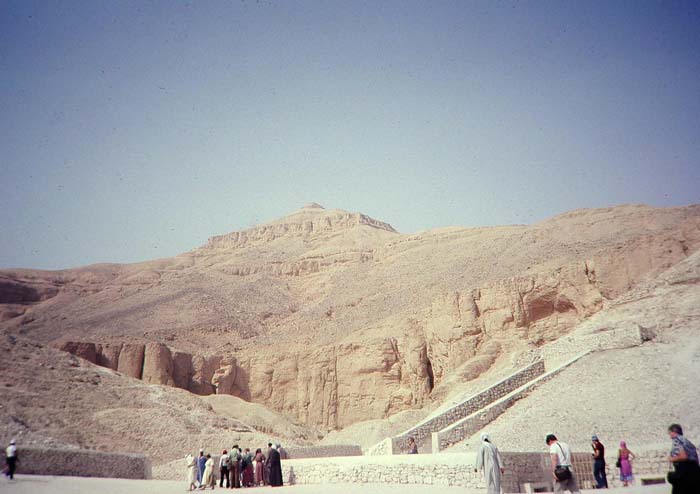
© Jimmy Smith - Entrance to the Tomb of Tutankhamun
Discovery and Robberies
The Discovery of the Tomb of Tutankhamun is one of the greatest archaeological finds in history that may never have been found. In fact, lawyer Theodore M. Davis believed he had already discovered the tomb and wrote about it in 1912. It turned out this hobbyist archaeologist was quite wrong.
With the financial aid of Lord Carnarvon, Egyptologist Howard Carter excavated around site KV62 in the Valley of the Kings in 1922. On November 4, he found a step. Sure it led to something great, he sent for the Lord, who arrived on November 22. Upon further examination, it was discovered that the first door excavators found had been broken and resealed at least twice. Moreover, they discovered a tunnel dug by tomb robbers in ancient times and refilled. This was the norm and why excavations rarely turned up anything of more than historical and scholarly value.
At the end of this tunnel, they found another door. This door too had been broken into and then resealed in ancient times. Thus, there was no reason to expect what was behind it and yet, when Howard Carter peered into the room for the first time, there was "everywhere the glint of gold". In spite of robbers' knowledge of the tomb's location, treasures beyond the Egyptologist's expectations lay beyond that door – treasures meant for the afterlife of King Tut.
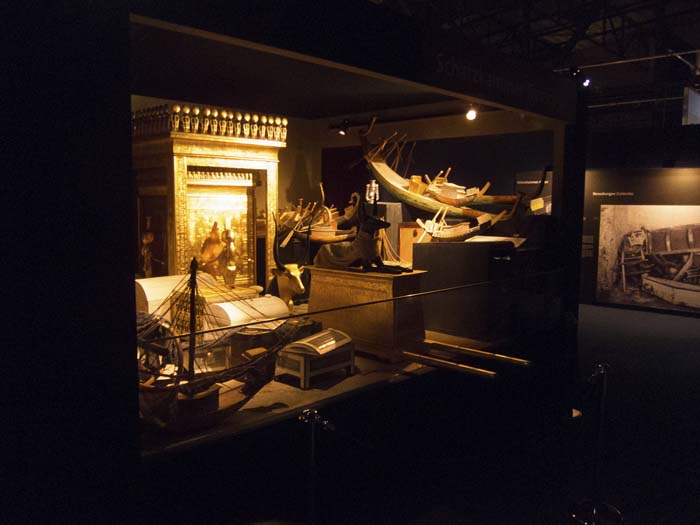
© Thomas Quine - Treasure from Tutankhamun's Tomb
Construction, Layout and Contents of the Tomb
The entry to King Tut's tomb is through the first doorway discovered by Howard Carter and his team. This leads down a corridor to a second door, which leads into the antechamber that was filled with golden chariots and other beautiful artifacts, all in a state of disarray because of the earlier ransacking.
One of the treasures found in this room was a golden throne with a depiction of the king sitting while his wife Ankhesenamun rubbed ointment on his shoulder. Behind the antechamber is the annex, which is the smallest room, but was home to thousands of objects. It was meant for the storage of oils, foods and the like. This was the room that suffered most from the first robbery. The perfumes and such within would have been worth much to people contemporary to the burial.
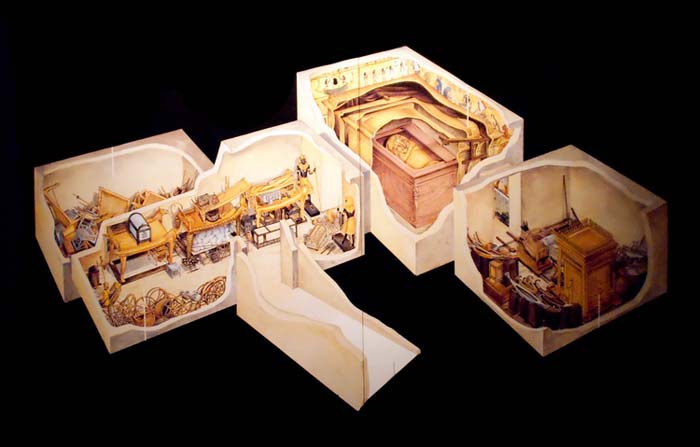
© Zsolt Andrasi - Rooms within Tutankhamun's Tomb
To the right of the antechamber is the burial chamber. This was the home of King Tut's sarcophagus, gorgeous funerary mask and the only decorated walls in the tomb. Surrounding the sarcophagus were four gilded shrines to the boy king. These surrounded the sarcophagus and essentially filled the room.
Beyond the burial chamber is the treasury, though plenty of treasure had already been discovered by the time this room was breached. It contained wine jars, a large golden Canopic chest, the mummies of what may have been stillborn babies of the king, and even more golden relics. Sadly, it is estimated that about 60% of the treasury's jewelry was stolen during the robberies.
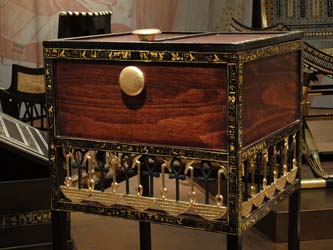
© Patty - Chest from the Tomb of Tutankhamun
King Tut Tomb Paintings
Decoration in the Tomb of King Tutankhamun is limited to the burial chamber. The walls of the chamber were quite bright, painted a vivid yellow that lasted through the years. The murals on the walls were also painted brightly. They were a bit large and lacked the fine details of other burials, which leads some to believe the king was entombed in a hurry.
On the Northern Wall, the Opening of the Mouth Ceremony is depicted as being performed by Ay, Tut's vizier. This ceremony was crucial to Ancient Egyptian burials, as it was believed that the dead would eat in the afterlife and the only way to ensure this was to perform the Opening of the Mouth ritual. Also on this wall appears to be a depiction of Tut starting his journey to the afterlife with Nut and greeting Osiris at the underworld with his soul or "Ka."
To the right of the Northern Wall is the Eastern Wall, which quite simply depicts the king being dragged to his tomb on a sled covered with a protective canopy. The Southern Wall, which was terribly damaged by Howard Carter and his team when they entered the room, showed King Tut with Isis, Anubis and Hathor. Finally, the Western Wall shows text from the Amduat. The upper left corner has Osiris in a boat with the sun god. The right has several other gods standing in a row. Below these pictures are 12 baboons representing the 12 hours of night that the king has to go through to reach the afterlife.
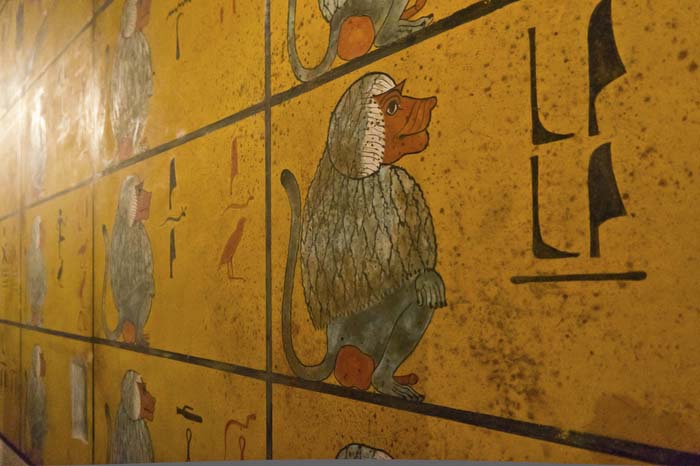
© Jean-Paul Remy - Decorative Baboons on the Wall of King Tut's Tomb
Hidden Chambers
While there is currently no evidence that there are hidden or undiscovered chambers in King Tut's tomb, there is healthy speculation. Some of this is fueled by the hope of discovering Queen Nefertiti's tomb. There are some indentations on the walls of the tomb that look like they could be doors. For some, that prompts the assumption that the tomb of Queen Nefertiti, the mother or stepmother of King Tut, lies beyond those walls. What's more, it could be undisturbed and even grander than Tut's tomb, which is widely presumed to have been rushed. It is logical to imagine this great queen's tomb to have been marvelous, but there is no evidence that she lays beyond Tut's tomb.
There is hope that technology will let archaeologists "see" behind the walls of Tut's tomb without damaging them. If it appears that King Tut's tomb is really a burial place skirting a larger complex, then arrangements could be made to continue excavation.
Interesting Facts About King Tut's Tomb
- In spite of its fame, King Tut's tomb is actually one of the smallest in the Valley of the Kings. This is likely in part because the burial was rushed with the king dying unexpectedly at a young age.
- King Tut's tomb was home to roughly 3,500 (some estimates are closer to 5,000) Ancient Egyptian artifacts. Some of these were simple statuary and objects thought necessary for the afterlife. However, a great many of them were jewelry or golden objects that are considered priceless today.
- Because Egyptologist Howard Carter wanted to study King Tut's mummy, it was removed from its sarcophagus. This had to be done with hot knives because drippings from the mummy had glued it to the inner walls of his coffin.
- Even in modern times, King Tut's tomb has been ransacked. One or several robbers got access to the mummy during the first half of the 20th century and not only jumbled up the corpse a bit, but stole the king's skull cap, the only remaining piece of jewelry on the mummy. Some believe they also took pieces of the mummy, but others believe those pieces, including the chest, were already missing because of an alleged bite from a hippopotamus.
